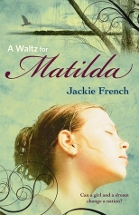A waltz for Matilda by Jackie French

HarperCollins, 2010. ISBN 9780732290214.
(Age 11+) Recommended. At the turn of the last century Australian women
lobbied for the right to vote, depression and drought caused widespread
unemployment and young men enlisted to fight in the Boer War. Trade
unions engaged in strikes, notably in the wool industry. Racism against
Chinese, Pacific Islander and indigenous people cast a shadow over the
colonies as they moved towards Federation.
Jackie French has woven these events into the story of Matilda
O'Halloran, who leaves the city after her mother's death to be reunited
briefly with her father before taking responsibility for his sheep
property. She develops from a determined 12 year-old factory worker
into a self-assured young woman.
The troubles and achievements of the era are an integral part of
Matilda's story. Her life is intertwined with those of a squatter,
striking shearers, indigenous and Chinese people and women campaigning
for female suffrage. She is directly linked to the creation of the song
'Waltzing Matilda'. At a deeper level, Matilda wonders about the
secrets in her family history and we discover, with her, that some of
these secrets are also part of our nation's history.
Behind the apparently effortless integration of narrative and character
development, there is evidence of considerable research and an
intuitive understanding of daily life in the past. The personal
journeys of all the characters, men and women, contribute to the
storyline, ensuring that the novel will have wide appeal.
The narrative is told in the third person but we hear Matilda's voice
in her letters. Some of her attitudes are unconventional for the time
but she is good-hearted and her independent thinking is convincing. The
author has prefaced the book with an apology for the use of racist
terms no longer in common use and provided endnotes which explain the
controversies of the era.
A waltz for Matilda is an engaging, well-crafted work of
historical
fiction. It is also an insight into a formative period in Australian
history and into the way in which history is revealed to us.
Elizabeth Bor